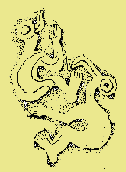
Closing the Triangle: A Quest for Rapa Nui

Polynesian Voyaging Society
Vision and Exploration
Nainoa Thompson recalls that his teacher Mau Piailug asked him once when they stood together at Lana'i Lookout on the southern coast of O'ahu in what direction Tahiti lay and could Nainoa see that island, 2500 miles away. Nainoa pointed to the SSE and replied he could see Tahiti in his mind. They were preparing to navigate without instruments to that island far below the horizon. Mau said, "Good-when you lose that vision you will be lost."
The Polynesian Voyaging Society was founded for the purpose of scientific inquiry into our history and heritage: How did the Polynesians discover and settle small islands in ten million square miles of ocean, geographically the largest "nation" on earth? How did they build canoes from limited resources on small islands? How did communities come together to combine resources, material, and manpower, to build and sail these voyaging canoes? How did they navigate withou instruments, guiding themselves across ocean distances of 2500 miles? And how did they transport the food necessary for societies to survive, then flourish on uninhabited islands?
Over the last 25 years PVS has built two voyaging canoes, Hokule'a and Hawai'iloa, and conducted five major open ocean voyages to answer these questions. The voyage to Rapa Nui is the sixth voyage, and we find ourselves still exploring. How did the Polynesians find this remote, isolated island smaller than Ni'ihau, which is the smallest major island in the Hawaiian Archipelago? How did they get there 1400 miles against the wind from Mangareva, where the settlers are believed to have originated? Once again we are challenged and excited about the opportunity to look for answers. There is no guarantee that we will find the island, but we are excited about learning, about discovering something new.
One of the important themes of this voyage to Rapa Nui is why we explore, and the process of exploring, envisioning something that's important in our lives, recognizing that we need to do research and plan out the details; that we need to build a community to support this kind of effort, that we have to prepare and train, that we need to take risk somewhere along the line to achieve things that are of great importance. We hope that this process of exploring we engage in inspires young people to visualize and pursue their own dreams.
We've been exploring physically outward in the last 25 years into the Pacific, and certain themes have emerged as important to us-education and protecting and preserving our beautiful environment, our rich heritage and culture, and our kinship with other Pacific Island nations who are really our ancestral families.
When we add all these themes up, we find they are really about relationships-among all of us as members of this community and between all of us and this beautiful place in which we live. Our work may be in history and culture, but it's really about finding ways in which we can all participate in trying to envision and shape the kind of future that we want not just for us, but for future generations.
The Voyage Home from Rapa Nui is in many ways for us more important than getting to Rapa Nui. The Voyage Home will allow us to articulate what home is and how we want to envision it. There are a million people here and they could choose to live elsewhere; but for most of us, we choose to live here because Hawai'i is an incredibly special, rare, unique place on earth. Its beauty, its mana, its relatively peaceful multi-ethnic community-we all have our definition of why it's special. During the Voyage Home from Rapa Nui, we hope to start a dialogue in the community about what makes Hawai'i special and how can we protect that which is so special.
During this voyage, Hokule'a is carrying the hopes, aspirations, and dreams of the many people who cared for her and touched her. We hope that this voyage inspires us and creates opportunities for us to be a community that's defined not by geographical or racial issues, but by the values which make it special.